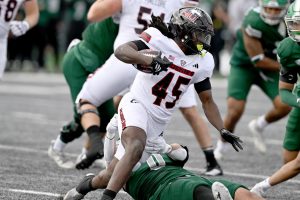Yellow rubber turns into gold
October 25, 2004
Cancer, a disease taking the lives of hundreds of thousands of Americans each year, might have finally met its match: plain, yellow bracelets.
Six-time Tour de France winner and cancer survivor Lance Armstrong’s foundation began selling “live strong” bracelets earlier this year with the goal of raising $5 million. Today, it’s nearing $20 million in sales.
The simple yellow wristbands have become surprisingly popular, especially among young people, according to Michelle Milford, associate director of public relations for the Lance Armstrong Foundation. She said the foundation has sold more than 19 million bracelets.
So what’s so special about these little yellow bands? Each bracelet costs only a dollar and all proceeds go towards the fight against cancer. But, considering the popularity and publicity the bracelets have received, are students really wearing them to support the cause, or are they just following the latest fashion trend?
“Some students … [feel] very strongly about supporting the fight against cancer. Some told me that they had family members or friends who died of cancer,” said Julie Hillery, NIU Kohl’s professor of retailing and merchandising. “Students today seem to be much more involved in social causes. So to be able to physically show that is something they would like. It also makes people feel good about themselves knowing that their donation is going to a good cause, even though it’s only a dollar. Other students definitely have them on because they ‘look cool,’ or it may give them a sense of belonging – a common cause.”
Ryan Brandenburg, a senior corporate communication and journalism double major, said he wears his bracelet for both reasons.
“It’s trendy right now to be wearing one,” he said. “Luckily, it’s for a good cause and that’s why I’m wearing mine.”
However, it isn’t just college students wearing the wristbands.
“We see a wide range of people wearing the wristbands – kids and grandparents,” said Bianca Bellavia, director of communications for LAF. “I think the younger kids can relate to [Armstrong’s] story,” she said. “I think college kids are especially eager to cling to a positive spirit.”
What did she have to say about the idea that the bracelets have become mostly a fashion statement?
“We [at LAF] have done some research,” Bellavia said. “We found most people who wear the bracelets do so because they feel [the fight against cancer] is a personal cause.”
For whatever reason people are wearing them, they are certainly more than eager to get them. The bands are on back order at LAF with delays of three to four weeks.
Hillery said the demand isn’t too surprising and actually reflects a popular trend from a few decades back.
“The phenomena of bracelets are very similar to the POW bracelets that were popular during the Vietnam War,” Hillery said. “Those metal bracelets contained the name of a soldier who was either POW or MIA and they were to be worn by the person until the soldier was either released or accounted for. A lot of people of all ages wore those in support of the soldiers.”
With strong demand for the nifty little bands, when will the trend end?
“We will continue selling [the live strong wristbands] until there is no more demand for them, and we don’t expect that to be anytime soon,” Bellavia said.






